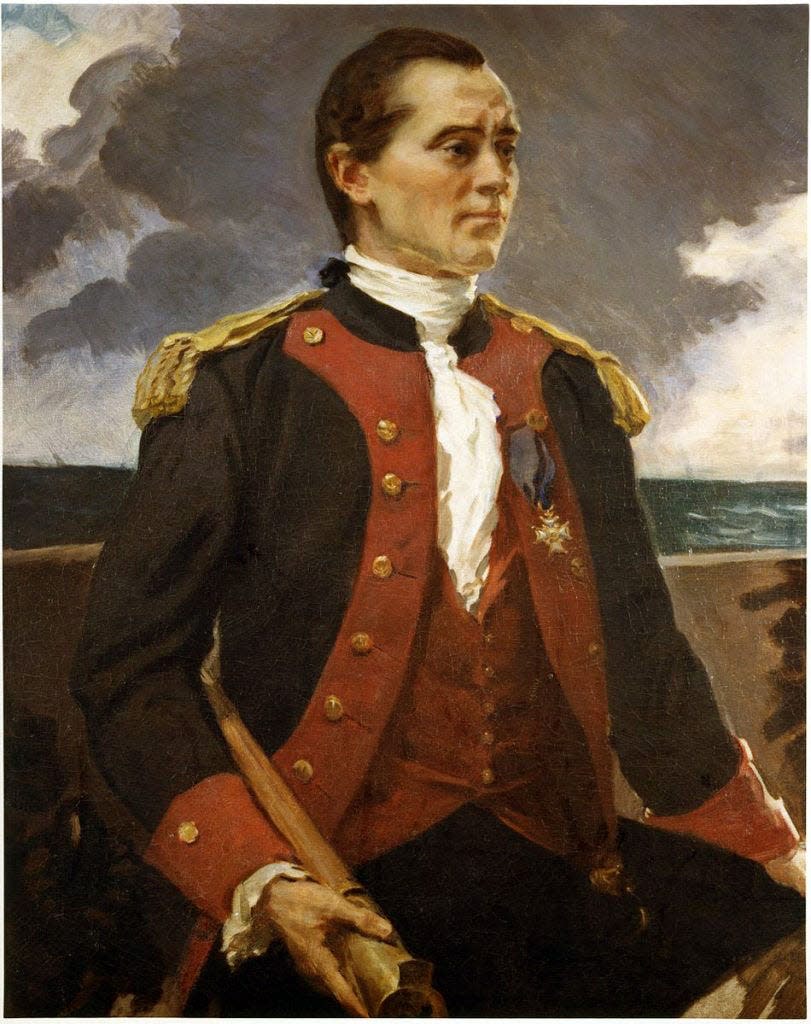Kerr: Let's give naval hero John Paul Jones the recognition he deserves
- Oops!Something went wrong.Please try again later.
- Oops!Something went wrong.Please try again later.
- Oops!Something went wrong.Please try again later.
John Paul Jones is to America’s Navy what the mythic Paul Bunyan was to the continent’s lumberjack trade – if Jones hadn’t actually existed, some imaginative soul would have been obliged to create him.

The fiery Scotsman was portrayed by foes as a pirate and an outlaw, but today he’s remembered as the Father of the U.S. Navy. And the 18-gun frigate Ranger, which brought him his first fame and notoriety during the American Revolution, was built right here in Kittery.
A small park in town near Memorial Bridge bears Jones’ name, and interpretive historical panels there share the story of the captain and his ship. However, the markers have been corroded by years of New England weather and need to be replaced.

A fundraising effort for the new panels is currently under way through something I like to call the JPJP (as in John Paul Jones Park) Project. As Kittery is home to the illustrious Portsmouth Naval Shipyard, it makes sense for the Navy’s most famous hero to be honored here as well.
Founding Father John Adams, always gifted in his way with words, once described Jones as “leprous with vanity” – and he actually liked the controversial naval officer. But Jones was also chivalrous, bold, visionary, and absolutely fearless in combat.
In the bloodiest moments of his most famous battle, aboard the Bonhomme Richard, Jones attempted to shoot one of his own crewmen for trying to raise the flag of surrender. When his pistol failed to discharge, he hurled it at the man’s head, knocking the offending sailor unconscious, and rallied his men to victory.
********
This future hero was born John Paul, a humble gardener’s son, on the 6th of July, 1747, at Arbigland, Scotland. He shipped out to sea with the British merchant marine at the age of 13 and was master of a vessel at just 21 years old. For a time early in his career he served aboard slave ships, which he called the “abominable trade.”
He fled to America from Tobago in 1773 after killing a sailor with his sword during an attempted mutiny, later claiming self-defense, and added “Jones” to his name. When the Colonies proclaimed their independence from Great Britain, he offered his services to the emerging young Continental Navy.
In 1777, construction of a ship originally to be called the Hampshire commenced on Kittery’s Badger’s Island, then known as Rising Castle Island. In June of that year, Congress appointed Jones captain of the vessel now dubbed the Ranger. Kittery’s own General William Whipple – a former sea captain who signed the Declaration of Independence as New Hampshire’s representative – was charged with helping to find a crew for the new warship. A good number were men from the Piscataqua area.
The local shipyard was owned by John Langdon of Portsmouth − another Founding Father, former member of the First Continental Congress, and signer of the U.S. Constitution. Jones, being Jones, bickered repeatedly with Langdon throughout the construction process.
James Hackett of Exeter, New Hampshire, the master shipbuilder contracted by Langdon to construct the Ranger, was an interesting character in his own right. As a youth of just 15 years old, Hackett had joined the legendary Roger’s Rangers during the French and Indian War, and survived several harrowing wartime escapades.
Which is how the vessel acquired her new name.
********
Jones and the Ranger departed for France on 1 November 1777. He was instructed by Congress – in orders delivered personally by his friend Whipple – to “Take, Sink, Burn or destroy all such of the enemies Ships, Vessels, goods and effects as you may be able.”
In February 1778, the Ranger became the first ship under the new American flag to be saluted by a foreign power, in the form of a nine-gun greeting from the flagship of a French admiral.
That April, Jones and crew embarked on an audacious one-ship raid on the British isles. On one occasion, some of the crewmen – disillusioned by the lack of prizes they had envisioned − plotted a mutiny against their captain. Jones caught wind of the plan and when the leader made his move, Jones pulled his pistol and held it to the sailor’s head.
The mutiny ended right there.
In the early morning hours of 23 April, the crew first raided the small port of Whitehaven. Jones himself led the landing party, which rowed to shore and spiked several cannons before setting fire to a coal ship in the harbor. The Americans barely escaped a mob of angry townspeople who chased them back to their boats and fired at them with the few remaining guns still operable.
From there, the Ranger proceeded across the bay to St. Mary’s Isle in Scotland, where Jones planned to kidnap a Scottish lord and exchange him for American prisoners. However, the Earl of Selkirk happened to be away from home. To appease his treasure-hungry crew, Jones allowed a couple of his officers to negotiate with the pregnant lady of the house to surrender her expensive silver tea set – which he later purchased and returned.
On 24 April, the Ranger engaged the 20-gun British warship HMS Drake near Carrickfergus, Ireland, and emerged victorious after the Drake’s two top officers were mortally wounded. This battle was perhaps the most famous sea victory for the Colonies at the time. Several of the King’s warships were dispatched to capture the Ranger, but none succeeded.
The Ranger returned to France with the Drake and about 200 prisoners, and captured or sank a couple of merchant vessels as well. As a military action Jones’ foray had little impact on the war, but in terms of propaganda it was a huge success. Jones, who had once been one of their own, became the subject of numerous articles, caricatures and ballads in Great Britain, and coastal towns shored up their defenses in preparation of another possible attack by this notorious “rogue.”
**** ****
Back in France, Jones reluctantly turned over command of the Ranger for the return trip to the Piscataqua while he awaited his next ship. He would go on to even greater fame aboard the 42-gun Bonhomme Richard after his September 1779 victory over the 44-gun HMS Serapis.
It was during this battle that Jones, his ship in flames and taking on water, is said to have offered his immortal retort when asked if he was ready to surrender − “I have not yet begun to fight!”
After the Revolutionary War ended, he served as an admiral in the Russian Navy under Catherine the Great. He eventually wound up back in Paris, dying alone in an apartment on 18 July 1792, at the age of 45.
More than a century later, his remains were discovered in a Paris cemetery and finally escorted back to the United States by a procession of American battleships in 1906. Jones was interred with grand ceremony at the United States Naval Academy in Annapolis, Maryland. President Teddy Roosevelt, anxious to re-establish America as a sea power at the time, presided over the proceedings.
Contributions for the new JPJP markers can be mailed to George Dow, KMIF, 1 Bartlett Road Kittery Point, ME 03905. Checks should be made out to the non-profit Kittery Maine Improvement Foundation, with JPJP Project written in the memo line to clarify the intent of the donation.
And as a matter of disclosure, I’m the pest pushing to make this happen.
D. Allan Kerr is a local history buff and member of the Portsmouth Athenaeum.
This article originally appeared on Portsmouth Herald: Kerr: Kittery, let's give John Paul Jones the recognition he deserves

